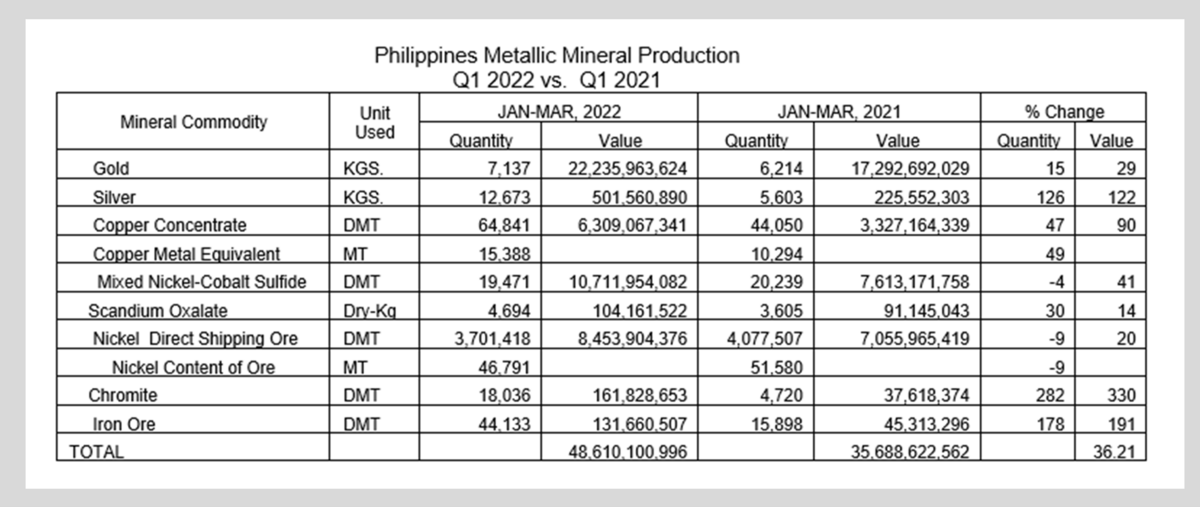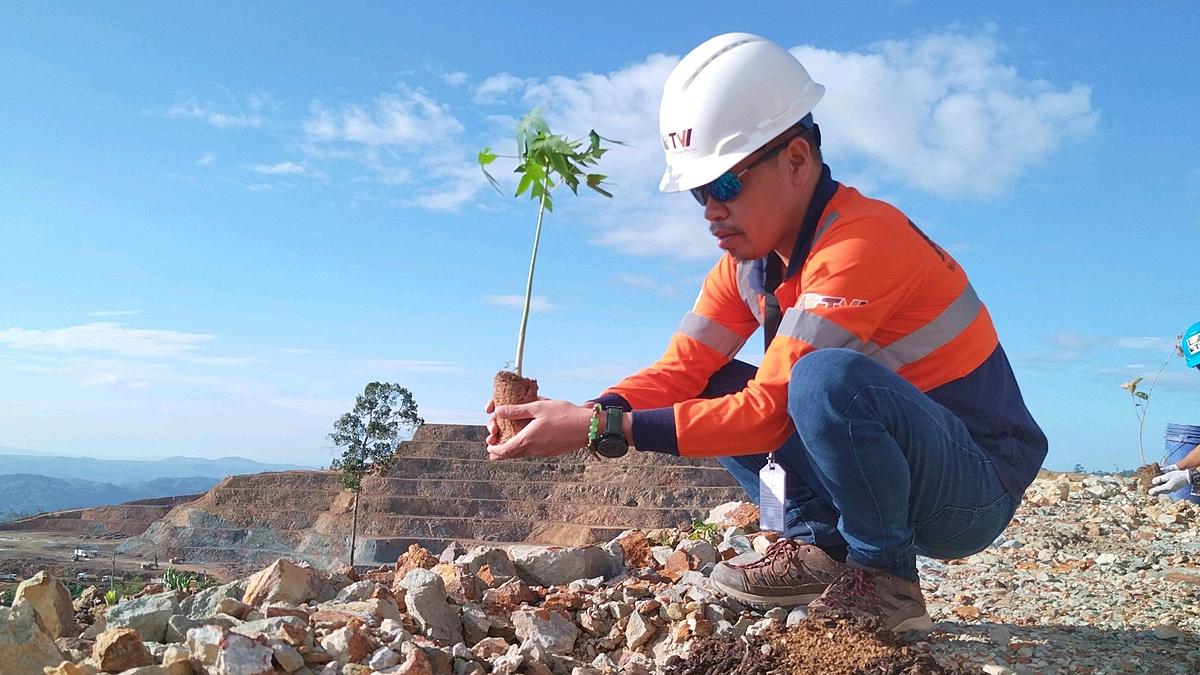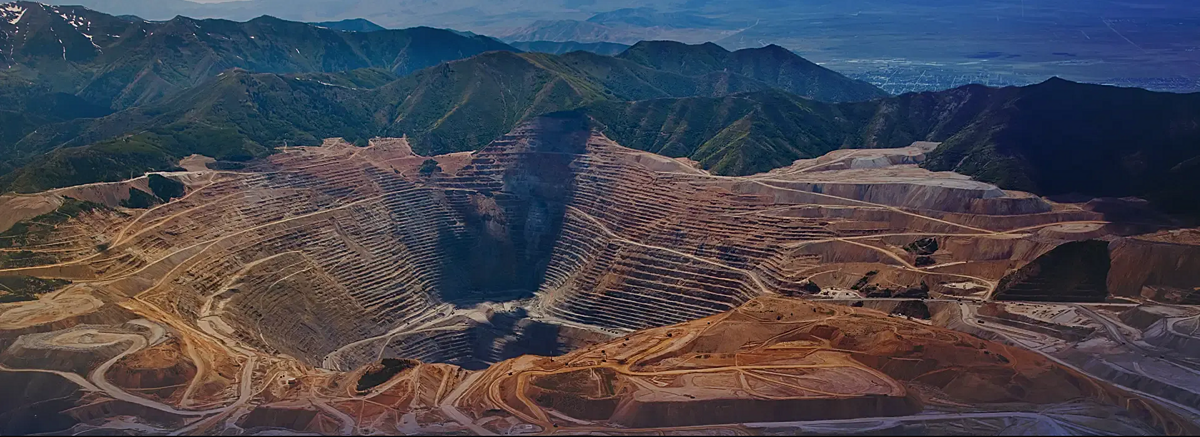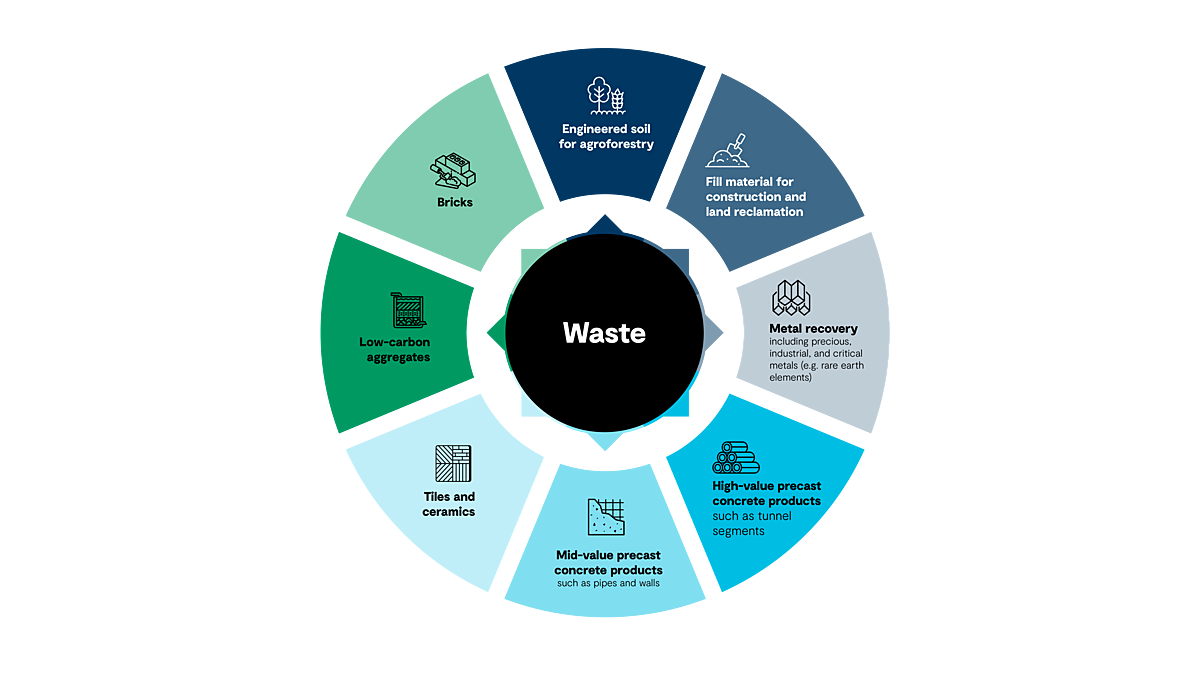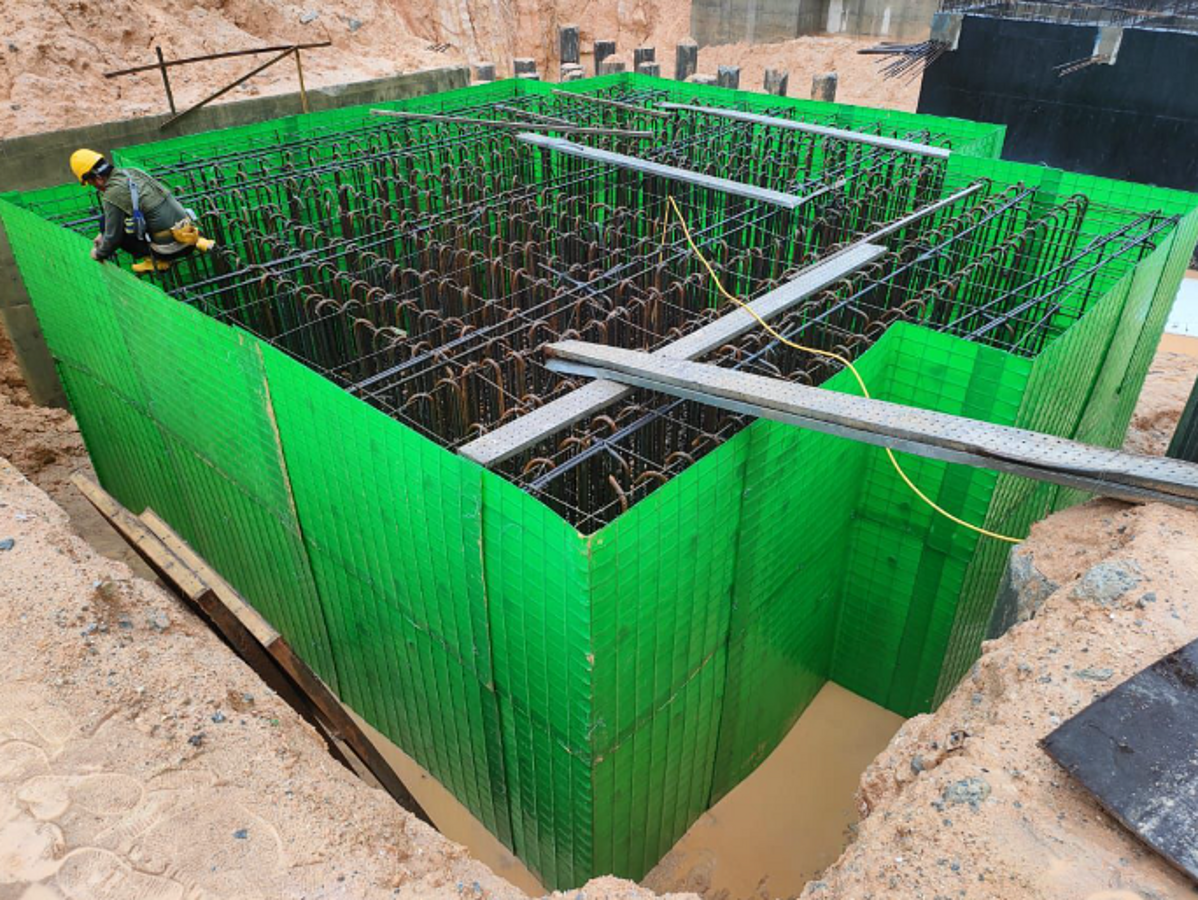Photo credit: MGB
The metallic mineral production value kicked off the year with a 36.21% or PhP12.92 billion growth from PhP35.69 billion in Q1 2021 to PhP48.61 billion in Q1 2022. Once again the bullish metal price during the period pushed the industry to this optimistic performance, coupled with the increase in the mine production of gold, silver, and copper.
Among the prices of metal, nickel was at an unparalleled level at US$28,089.77 per metric ton from a US$17,625.46 per metric ton, year-on-year, more than 59% or a US$10,464 increase. Copper followed with an almost 18% growth from US$8,478.58 per metric ton to US$9,986.01 per metric ton, year-on-year while the yellow metal enjoyed a US$73 increase from US$1,801.86 per troy ounce to US$1,874.91 per troy ounce. We are seeing prices of metals at heights way beyond their pre-pandemic levels.
In terms of contribution to the total production value in Q1 2022, gold took the spotlight with a substantial share of 45.74% or PhP22.24 billion. The collective values of direct shipping nickel ore together with its nickel products, mixed nickel-cobalt sulfide, and scandium oxalate took the second spot accounting for 39.64% or PhP19.27 billion. Meanwhile, copper followed with 12.98% or PhP6.31 billion while the shared output value of silver, chromite, and iron ore contributed 1.64% or PhP0.80 billion.
Major mining hubs in the country include the following Regions: Caraga is host to 23 operating mines or about 42% of the country’s total with 20 nickel mines, 2 gold mines, 1 chromite mine, and 2 mineral processing plants (gold and hydrometallurgical); Regions III and VIII with both 6 mines; Cordillera Administrative Region with five; and Palawan province with 3 nickel mines and a hydrometallurgical processing plant. For the complete number of mines per Region refer to Figure 4.
In terms of the number of mines by commodities, the country has 32 nickel, 12 gold, 4 chromite, 4 iron, and 3 copper a total of 55 large-scale mines. During the review period, however, 20 mines reported zero production due to unfavorable weather conditions most particularly in the area of Mindanao, while others were still under care & maintenance status or under suspension. Aside from these large-scale mines that are holders of Mineral Production Sharing Agreement, Financial or Technical Assistance Agreement (FTAA), and Mining Lease Contract, there are also small-scale mines in operation
For the yellow metal, production volume and value in Q1 2022 grew by 15% and 29%, respectively from 6,214 kilograms with an estimated value of PhP17.29 billion to 7,137 kilograms with an estimated value of PhP22.24 billion, year-on-year. Among the producers, the Masbate Gold Project of Philippine Gold Processing & Refining Corporation (PGPRC) recorded the highest output with 1,859 kilograms with an estimated value of PhP5.79 billion followed by the Didipio Copper-Gold Project of OceanaGold (Phils) Inc. (OGPI) with 917 kilograms with an estimated value of PhP2.84 billion. The third was Co-O Gold Project of Philsaga Mining Corporation with 706 kilograms with an estimated value of PhP2.21 billion.
In addition, in terms of the overall contribution to the country’s production value gold has once again taken the driver's seat from nickel at PhP22.24 billion in Q1 2022. Strikingly, covering the period 2012 up to 2021 gold has taken the backseat next to nickel with the exemptions of 2016 and 2017 where it led. Prior to 2012, historical data will show that gold has always dominated the country’s production value.
For a refresher, in 2012 nickel and mixed nickel-cobalt sulfide for the first time outperformed gold mainly due to the overwhelming 94% slump in BSP gold purchases from small-scale miners/traders from 17,638 kilograms in 2011 to only 1,090 kilograms in 2012. This situation in 2012 seemed to be brought about by the collection by the Bureau of Internal Revenue (BIR) of the 2% excise tax and 10% creditable withholding tax from small-scale miners pursuant to Revenue Regulations No.7-2008, dated 25 March 2008. In addition, on April 2, 2012, the BIR issued Revenue Regulation No. 6-2012. Said Regulation clarified the taxability of the sale of gold by any person or entity to another person or entity other than the BSP. A major provision in the said Regulation is the reduction in the creditable withholding tax from 10% to 5%. In 2019, the government issued the policy, Republic Act No. 11256 (An Act to Strengthen the Country’s Gross International Reserves (GIR), amending the Purpose Sections 32 and 151 of the National Internal Revenue Code, as amended, and for Other Purposes). Salient features of said Regulation are the tax exemptions for the following transactions: (a) Income derived from the following sale of gold is excluded in the gross income and shall be exempt from income tax, and consequently from withholding taxes for the sale of gold to the BSP by registered SSMs and accredited traders and the sale of gold by registered SSMs to accredited traders for eventual sale to BSP; and (b) Excise tax shall not be levied, assessed and collected for the sale of gold to the BSP by registered SSMs and accredited traders; and the sale of gold by registered SSMs to accredited traders for eventual sale to BSP. General outlook, with the enactment of RA No.11256 and the continuous declaration of MB the government remains confident that BSP gold purchases will grow. The sale of 25% of OceanaGold’s monthly dore to BSP as indicated in their FTAA will likewise boost the gold reserve of BSP. This initiative by the Mines Geosciences Bureau (MGB) will also provide the BSP with additional sourcing to strengthen the gold reserve of the country. The reported gold dore production of OceanaGold in Q1 2022 was 276 kilograms with an estimated value of PhP852 million. Along this line, for future Mineral Agreements and FTAAs, the MGB is looking into including in the Agreements the selling of a certain percentage of the Contractors dore production to BSP.
The white metal stood tall as both production volume and value grew by 126% and 122% respectively from 5,603 kilograms with an estimated value of PhP225.55 million to 12,673 kilograms with an estimated value of PhP501.56 million. The entry of Balabag Gold-Silver Project of TVI Resource Development (Phils) Inc. in Zamboanga del Sur into the production scene was the main factor for this impressive showing. TVI accounted for almost 41% or 5,155 kilograms with an estimated value of PhP204.10 million of the country’s total silver production. While the former leader Apex Maco Operation of Apex Mining Corporation came in second with 2,966 kilograms with an estimated value of PhP116.43 million followed by Masbate Gold Project of PGPRC with 1,436 kilograms with an estimated value of PhP57.13 million. The initial production of TVI was made last September 2021.
On nickel direct shipping ore production volume incurred a deficit of 9% while value went up 20%, from 4,077,507 dry metric tons with an estimated worth of PhP7.06 billion in Q1 2021 to 3,701,418 dry metric tons with an estimated worth of PhP8.45 billion in Q1 2022. Rio Tuba Nickel Mining Corporation led the pack with 1,028,119 dry metric tons followed by Taganito Mining Corporation with 451,265 dry metric tons. Consequently, of the 32 listed nickel mines about 44% or 14 mining projects reported zero production in Q1 2022 largely because of the unfavorable weather condition that prevailed in the region of Mindanao. In terms of production distribution by province, upfront was Palawan with 1,303,377 dry metrics tons. This was the combined output of Rio Tuba Nickel Mining Corporation and Citinickel Mines & Development Corporation. Trailing behind Palawan was Zambales Province with 1,144,889 dry metric tons, all 5 nickel mines in the region recorded production. Agusan del Norte and Surigao del Norte grabbed the 3rd and 4th spot accounting for 560,906 dry metric tons and 485,200 dry metric tons, respectively. Other provinces with mine production were Surigao del Sur with 168,269 dry metric tons, Davao Oriental with 33,314 dry metric tons, and Dinagat Island Province with 5,462 dry metric tons. While Eastern Samar with two nickel mines and Isabela province with one nickel mine reported zero production in Q1 2022. Looking closely despite being down by 9% or 376,089 dry metric tons, production value went up by 20% from PhP7.06 billion to PhP8.45 billion, up by almost PhP1.40 billion. This growth was powered by the robust price of nickel during the period. As seen in Figure 6 prices were way above their pre-pandemic levels. In Q1 2022 it peaked at as high as US$37,790 per metric ton in March while in CY 2021 the highest monthly average price happened in December at US$20,070 per metric ton. Whereas the highest average monthly price enjoyed for CY 2019 and CY 2020 was US$17,663 per metric ton and US$16,807 per metric ton, respectively. Experts said that the factors that triggered this extraordinary hike were: (1) Investors’ concern over the conflict between Russia and Ukraine; (2) Supply chain disruptions; and (3) A short squeeze that pushed London Metal Exchange to halt trading for several days in Mid-March.
For the rest of 2022 experts say that the demand for nickel will be fueled by the battery sector as battery producers and carmakers anticipate the transition to electric vehicles. In terms of nickel use by application stainless steel remains to dominate at about 74% while batteries are seen to be gaining ground at 11% in 2021 and are forecasted to grow to 13% this year experts say.
On mixed nickel-cobalt sulfide production of Coral Bay Nickel Corporation and Taganito HPAL Nickel Corporation (THPAL), it went down by 4% from 20, 239 dry metric tons to 19,471 dry metric tons year-on-year. Production value, however, went up by as much as 41% from PhP7.61 billion to PhP10.71 billion, year-on-year, about a PhP3.10 billion increment. While production volume and value of scandium oxalate of THPAL grew by as much as 30% and 14%, respectively from 3,605 Dry-Kg with an estimated value of PhP91.14 million to PhP4, 694 Dry-Kg with an estimated value of PhP104.16 million, year-on-year. The scandium oxalate is a by-product of THPAL’s operation.
The red metal, which accounted for almost 13%, or PhP6.31 billion, of the total metallic mineral production value, enjoyed a sizeable increase in production volume and value of 20,791 dry metric tons and PhP2.98 billion from 44,050 dry metric tons with an estimated value of PhP3.33 billion to 64,841 dry metric tons with an estimated value of PhP6.31 billion, year-on-year. Toledo Copper Project of Carmen Copper Corporation in Cebu contributed 55%, or 35,423 dry metric tons, while in far second and last position were Didipio Copper-Gold Project of OGPI in Nueva Vizcaya, and Padcal Copper-Gold Project of Philex Mining Corporation in Benguet Province with 15,452 dry metric tons and 13,966 dry metric tons, respectively. The general growth in the production volume was primarily due to the re-entry of OceanaGold to the production-stream same period last year OGPI reported no production. In addition to OGPI’s output, the telling factor for the growth in production value was the upbeat price of copper from US$8,478.58 per metric ton to US$9,986.01 per metric ton year-on-year, up by US$1,507. Figure 7 exhibited the movement of the copper price before the onset and during the COVID-19 pandemic from CY 2018 up to Q1 2022. Copper has multiple uses and is seen as one of the most strategic commodities as far as metals go.
Chromite production volume and value also went up during the period from 4,720 dry metric tons with an estimated value of PhP37.62 million to 18,036 dry metric tons with an estimated value of PhP161.83 million. Only Techiron Resources, Inc and Taganito HPAL Nickel Corporation reported production. The substantial growth was due to THPAL’s chromite input which incidentally is a by-product of their mixed nickel-cobalt sulfide operation. Krominco, Inc in Caraga remained under care & maintenance status.
On iron ore, production volume and value increase from 15,898 dry metric tons with an estimated value of PhP45.31 million to 44,133 dry metric tons with an estimated value of PhP131.66 million, year-on-year a difference of 28,235 dry metric tons and PhP86.35 million. This positive result was courtesy of Ore Asia Mining & Development Corporation located in Bulacan. Same period last year said company reported no production. The other producer located in Leyte Province was MacArthur Iron Project Corporation/Strongbuilt Mining & Development Corporation with 3,009 dry metric tons. While Vitali Iron Ore Mining Project of Atro Mining-Vitali Iron Inc. in Zamboanga del Sur still reported no production.
Outlook on the local front, the MGB is aiming for the sustained development of the minerals sector and to this effect, the Bureau has planned a road map over the course of 18 years. This road map is divided into three phases: (1) Enhancing investors' confidence in the mineral sector (2022-2024); (2) Expanding domestic ore production and mineral asset (2023-2030); and (3) the Philippines to level-up to the global mineral markets in the field of semi-processed and fully processed mineral products (2026-2040).
To articulate the 1st Phase - Enhancing investors' confidence in the mineral sector, the government has initiated game-changing and enabling policies like Executive Order No. 130 (Amending Section 4 of E.O. No. 79, S. 2012, Institutionalizing and Implementing Reforms in the Philippine Mining Sector, Providing Policies and Guidelines to Ensure Environmental Protection and Responsible Mining in the Utilization of Mineral Resources); DAO No. 2021-25 (The Implementing Rules and Regulations of Executive Order No 130); and DAO 2021-40 (Lifting of the Ban on the Open Pit Method of Mining for Copper, Gold, Silver, and Complex Ores in the Country Under DENR Administrative Order No. 2017-10, and Providing Additional Enhanced Parameters and Criteria for Surface Mining Methods). In addition, the Bureau is also stirring towards the following activities: Expanding the collection of geosciences and mineral information database both onshore and offshore; Identifying new mineral reserves, and Design mineral extraction to minimize environmental footprint.
With the institutionalization of Phase 1, the government is optimistic about the realization of the 2nd Phase - Expanding domestic ore production and mineral asset, which targets to increase and attract mineral/mining-related investment to build up national economy. This would mean an expansion of the production capacity of existing mining projects and the entry of new players to the production bandwagon. Other specific programs under this phase are to bid out national government mining assets under Privatization Management Office and Philippine Mining Development Corporation within 3 years. Basay Mining Corporation, Maricalum Mining Corporation, and Nonoc Mining and Industrial Corporation are only some of the referred government mining assets. During this phase, the government would also like to see a much develop and expanded support infrastructure going to mineralized areas (roads, power, rails, communication technology, etc.). Also under this phase, the government would push for the construction of modular processing plants for value-added in the minerals sector.
Finally for the 3rd Phase - the Philippines to level up to the global mineral markets in the field of semi-processed and fully processed mineral products. Under this phase, specific programs include: (1) The mandate of the establishment of mineral smelting and refining facilities, iron making industry, and nickel refineries this move is to expand the export of value-added mineral products; (2) Conduct research on the re-use of mining waste and tailings for other industrial use, mine rehabilitation, and acid mine drainage management using the Development of Mining Technology and Geosciences fund under the Social Development and Management Program; and (3) Build-up technical capacity both in the government institutions and private sector. During the 3rd phase, the government anticipates a full-blown downstream sector and the establishment and expansion of the upstream sector of the minerals industry.
All things considered, the proper implementation of this roadmap would translate to growth in investment, trade, revenue, and employment opportunities. While these are all good reality check challenges currently facing the mining industry and investors include the following:
- High energy/fuel cost compared to other countries in Asia the Philippines has one of the most expensive power/energy costs;
- Big concern on peace and order situation in the remote areas where mining is being undertaken;
- Lack/limited support infrastructure going to mineralized areas like roads, power, rails, and communication technology;
- Low acceptability/popularity of mining in the country as a major source of livelihood and revenue for the national economy;
- Environmental footprints; and
- Concerns about the strength/stability in terms of policies related to mining, especially with the incoming administration
Article courtesy of the MGB. Full article and figures can be found HERE

